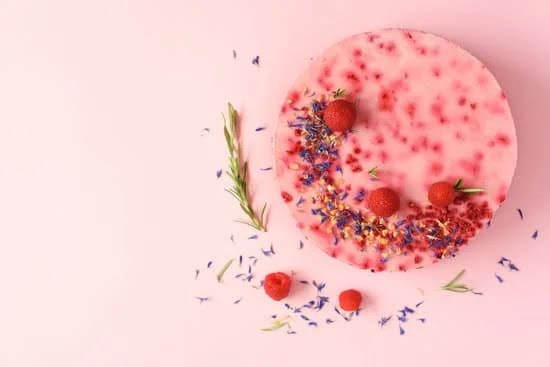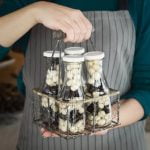Cake decorating is an art form that allows bakers to showcase their creativity and elevate the look of their delicious creations. While there are a plethora of tools and techniques available for this purpose, one versatile and cost-effective tool that often goes unnoticed is the humble plastic bag.
Yes, you read that right. In this article, we will delve into the world of cake decorating and explore how to use a plastic bag as a game-changing tool in creating stunning designs on your cakes.
Plastic bags may not seem like an obvious choice when it comes to cake decorating, but they offer a multitude of benefits. Not only are they easily accessible and affordable, but they also provide a wide range of options for different cake decorating techniques. Whether you’re a beginner or an experienced baker, using a plastic bag can help you achieve professional-looking results without breaking the bank.
Choosing the right plastic bag for cake decorating is crucial to ensure optimal performance and control. In this article, we will share tips and tricks on selecting the best type of plastic bag for your specific needs. Additionally, we will guide you through the process of cutting and prepping the plastic bag correctly to maximize its efficiency in creating beautiful designs on your cakes.
Get ready to unleash your creativity as we explore essential cake decorating techniques using a plastic bag. From basic piping techniques to more advanced patterns, we will walk you through step-by-step instructions on how to achieve stunning results with this versatile tool. Prepare to be amazed by the endless possibilities that await you in the world of plastic bag cake decorating.
In order to overcome challenges that may arise while using plastic bags for cake decorating, troubleshooting common issues becomes essential. We will address common challenges that decorators face when working with these bags and provide practical solutions to ensure smooth sailing throughout your decorating process.
So let’s dive into this exciting journey together as we embrace the creativity and convenience that plastic bags bring to cake decorating. Whether you’re a novice looking to learn the basics or a seasoned pro searching for advanced tips and tricks, this article will equip you with everything you need to take your cake decorating skills to new heights using nothing more than a simple plastic bag.
Why Plastic Bags are a Game-Changer in Cake Decorating
Plastic bags have become an essential tool in the world of cake decorating, and for good reason. They provide a level of convenience and versatility that is unmatched by traditional piping bags. Whether you’re a beginner or an experienced baker, using plastic bags can be a game-changer in your cake decorating journey.
One of the main reasons why plastic bags are so popular in cake decorating is their affordability and accessibility. Plastic bags are readily available at grocery stores or online, making them easily accessible to home bakers. Compared to traditional piping bags, which can be more expensive and harder to find, plastic bags are a cost-effective alternative.
Another advantage of plastic bags is their flexibility. Unlike rigid piping bags, plastic bags can easily be manipulated to fit any hand size or shape. This allows for better control and precision when decorating cakes. Additionally, the softness of the plastic allows decorators to easily squeeze out different amounts of icing for various designs and patterns.
Furthermore, using a plastic bag eliminates the need for messy cleanup. Traditional piping bags often require special cleaning tools and techniques to remove hardened icing, whereas plastic bags can simply be thrown away after use. This not only saves time but also reduces the amount of waste generated during the decorating process.
Choosing the Right Plastic Bag for Cake Decorating
Size Matters: Selecting the Proper Plastic Bag Size
When it comes to choosing the right plastic bag for cake decorating, size matters. The size of the plastic bag will depend on the scale of your cake design and the amount of icing you plan to use. For smaller designs or intricate details, a smaller plastic bag with a smaller tip may be more suitable. Conversely, for larger cakes or designs that require more icing, a larger bag with a larger tip may be necessary.
Consider Material and Thickness
In addition to size, consider the material and thickness of the plastic bag. Opt for bags made specifically for food use, as they are designed to be safe and hygienic. Look for bags that are made from thick, durable plastic to ensure they do not burst or tear while piping the icing onto your cake. It is also important to choose bags that are food-grade and free from harmful chemicals.
Disposable vs Reusable Bags
Another factor to consider when choosing a plastic bag for cake decorating is whether you prefer disposable or reusable bags. Disposable bags are convenient because they can be thrown away after each use, eliminating the need for cleaning and storage. On the other hand, reusable bags are more environmentally friendly and economical in the long run. They can be washed and used multiple times, making them a sustainable option for avid bakers.
Tips and Tricks
- If you’re unsure about which size or type of plastic bag to use, start by practicing with different options on parchment paper before applying them directly onto your cake.
- Consider using transparent plastic bags so you can easily see how much icing is left inside.
- To prevent an unwanted mess while filling the bag with icing, place it inside a tall glass or container and fold back the edges over its rim.
- Always make sure there are no air pockets in the bag before you begin using it. Squeeze out any excess air, as this can cause uneven icing flow.
By taking the time to choose the right plastic bag for cake decorating, you can enhance your overall experience and achieve more professional results. Remember to consider the size, material, and whether you prefer disposable or reusable bags. With these tips and tricks in mind, you’ll be well-equipped to embark on your cake decorating journey with confidence.
Preparing the Plastic Bag for Cake Decorating
Cutting the Plastic Bag
When preparing a plastic bag for cake decorating, one of the first steps is cutting the bag to create a small opening for piping. To do this, start by choosing a plastic bag made of thick, sturdy material that will not easily tear or burst when pressure is applied. This will ensure cleaner and more precise piping.
To cut the plastic bag, use a pair of sharp scissors. Begin by folding the top of the bag over two to three times to reinforce it and provide a stronger grip. Then, make a small diagonal cut at the tip of the bag, about ⅛ inch in diameter for smaller designs or up to ¼ inch for larger ones.
Prepping the Plastic Bag
After cutting the plastic bag, it’s important to prepare it properly before adding frosting or icing. First, unfold the top of the bag and pull it back halfway down. This will help you control and guide the flow of icing as you pipe.
Next, push any excess air out of the bag by squeezing from the folded area downward towards the tip. This step is crucial as trapped air can cause uneven and inconsistent flow while decorating your cake.
Once all excess air has been squeezed out, twist the top part of the bag tightly to secure it in place. Alternatively, you can use rubber bands or twist ties to ensure that no icing leaks out during piping.
Using Couplers and Tips
For more advanced cake decorating techniques using a plastic bag, consider using couplers and tips. A coupler is a device that allows you to easily change tips without having to transfer frosting between bags. It consists of two parts: a base piece that fits inside the plastic bag and a ring that holds different tips securely in place.
To use a coupler with your plastic bag, simply snip off a small part at the tip of the bag and insert the base piece. Then, place the desired tip onto the base piece and secure it with the ring. This will give you more control over different piping styles and enable you to create intricate designs on your cake.
Essential Cake Decorating Techniques Using a Plastic Bag
Plastic bags can be a versatile tool in cake decorating, allowing you to achieve a wide range of designs and techniques. Whether you are just starting out or looking to expand your skills, using a plastic bag can help you create beautiful and professional-looking cakes. In this section, we will explore some essential cake decorating techniques using a plastic bag, from basic to advanced.
- Piping Borders: One of the most basic cake decorating techniques is piping borders. With a plastic bag, you can easily create different border designs such as dots, shells, and zigzags. Simply fill the bag with icing or buttercream, cut a small hole at the tip of the bag, and apply pressure as you guide the bag around the cake’s edges. Practice different pressures and movements to achieve various border styles.
- Writing: Adding personalized messages or names to cakes is another popular technique in cake decorating. Using a plastic bag allows you to have more control over your writing than with traditional piping bags.
Fill the bag with icing or melted chocolate, cut a small hole at the tip of the bag, and practice writing on parchment paper before attempting it on the cake. Start by lightly tracing your desired message on the cake with toothpicks or food-safe markers as a guide. - Creating Texture: Plastic bags are great for creating textured designs on cakes that mimic certain patterns or effects. For instance, if you want to achieve a basket weave pattern, fill one side of the plastic bag with brown icing for lines and another side with white icing for spaces between lines.
Cut off the corner of the filled side and pipe vertical lines onto the cake. Once completed, use an offset spatula to smooth out each line while dragging it horizontally across the lines.
By mastering these basic techniques using a plastic bag, you can then progress to more advanced methods such as layering colors for an ombre effect, creating intricate floral designs by varying pressure, or even experimenting with different piping tips inside the bag. Remember to practice, be patient, and have fun exploring the endless possibilities that using a plastic bag brings to cake decorating.
Creating Beautiful Designs with a Plastic Bag
One of the main advantages of using a plastic bag for cake decorating is the ability to create beautiful and intricate designs with ease. Whether you’re a beginner or an experienced baker, there are various piping techniques that can be achieved using a plastic bag. From basic lines and dots to more advanced patterns and textures, the possibilities are endless.
One of the most common piping techniques is creating borders and outlines on cakes. This can be done by cutting a small hole at the tip of the plastic bag and gently squeezing out the icing in a controlled manner. By varying the pressure applied to the bag, you can create thin or thick lines, which can be used to outline shapes or create decorative borders around your cake.
Another popular technique is known as rosette piping, which involves creating swirls or rosettes on top of cakes or cupcakes. To achieve this, simply cut a larger hole at the tip of your plastic bag and pipe in a circular motion starting from the center and working your way outwards. The result is a beautiful floral design that adds an elegant touch to any dessert.
If you’re feeling more adventurous, you can try your hand at more intricate patterns such as basketweave or lace designs. These techniques require more practice but can yield stunning results. Basketweave involves alternating horizontal and vertical lines to create a woven effect, while lace designs mimic delicate lace patterns commonly found on wedding cakes.
| Piping Technique | Description |
|---|---|
| Outline Piping | Create precise outlines and borders for your cakes. |
| Rosette Piping | Create swirls or rosettes on top of cakes and cupcakes. |
| Basketweave | Create a woven effect by alternating horizontal and vertical lines. |
| Lace Designs | Mimic delicate lace patterns for an elegant touch. |
Troubleshooting
Plastic bags have revolutionized the world of cake decorating, providing bakers with a versatile and convenient tool for creating beautiful designs. However, as with any technique or tool, there can be challenges that arise when using plastic bags for cake decorating. In this section, we will explore some of these common challenges and provide practical solutions to help you overcome them.
One common challenge that beginners may encounter when using plastic bags is controlling the flow of icing or frosting. It can be tricky to achieve the desired consistency and pressure needed to create smooth lines or intricate designs. To overcome this challenge, it is important to practice using different amounts of pressure on the bag while piping.
Start with a small amount of pressure and gradually increase as needed. Additionally, choosing the right size plastic bag tip can also make a difference in controlling the flow of icing or frosting. Experiment with different tip sizes until you find one that suits your needs.
Another challenge that may arise is clogging or blockages in the plastic bag tip. This can happen if small particles from ingredients such as sprinkles or fruit pieces get stuck in the tip. To avoid this issue, it is recommended to strain your icing or frosting before placing it in the plastic bag. Use a fine-mesh sieve or cheesecloth to remove any lumps or solid particles that could potentially clog the tip.
| Challenge | Solution |
|---|---|
| Controlling flow of icing/frosting | Practice different amounts of pressure; choose appropriate tip size |
| Clogging/blockages in bag tip | Strain icing/frosting before placing in bag; use a fine-mesh sieve or cheesecloth |
| Icing/frosting consistency issues | Adjust consistency with additional powdered sugar or liquid; test on a small surface area first |
| Bag bursting or leaking | Ensure bag is not overfilled; reinforce weak spots with tape if necessary; handle with care to avoid undue pressure on the bag |
By addressing these common challenges and utilizing the suggested solutions, you can overcome any obstacles that may arise when using plastic bags for cake decorating. With practice and patience, you will soon master the art of cake decorating and create stunning designs with ease. Stay tuned for the next section, where we will explore advanced tips and tricks to take your cake decorating skills to the next level using plastic bags.
Taking your Cake Decorating Skills to the Next Level
One of the great things about using plastic bags for cake decorating is that they allow for endless creativity and versatility. In this section, we will explore some advanced tips and tricks to take your cake decorating skills to the next level using plastic bags.
- Experiment with Different Nozzles: While a plastic bag with a cut tip can create beautiful designs, using different nozzles can add variety and intricacy to your cake decorations. Some plastic bag tips include star-shaped, round, or leaf-shaped nozzles. These nozzles attach securely to the cut tip of the bag, allowing you to pipe out different shapes and patterns with ease.
- Layering Colors: Plastic bags are excellent for easily layering different colors in your cake decorations. To achieve this effect, fill separate sections of a plastic bag with different colored icing or frosting. Gently squeeze the bag to release multiple colors at once, creating stunning multi-colored designs on your cakes.
- Embellishments and Textures: Take advantage of the texture capabilities of plastic bags by adding embellishments to your cake designs. You can use items such as small candy pieces or sprinkles inside the bag before filling it with icing or frosting. When you pipe out the mixture onto the cake, these additions will create a visually appealing texture.
- Reverse Piping Technique: The reverse piping technique is an advanced method where instead of applying icing or frosting directly onto the cake, you pipe it onto parchment paper first and then transfer it onto the cake. This technique allows for precise detailing and intricate designs that may be challenging otherwise.
With these advanced tips and tricks, you can elevate your cake decorating skills using plastic bags as your go-to tool. Don’t be afraid to experiment and try new techniques to unleash your creativity in designing stunning cakes.
Remember:
- Practice makes perfect when using advanced techniques.
- Start with simple designs and gradually progress to more complex ones.
- Always maintain control over the plastic bag’s pressure to avoid accidental spills or smears.
Safety and Hygiene
Proper cleaning and storage of plastic bags is essential to ensure safety and maintain hygiene when using them for cake decorating. By following these guidelines, you can prolong the life of your plastic bags and prevent any potential contamination.
Cleaning plastic bags after each use is crucial to remove any leftover icing or food particles. To clean a plastic bag, start by turning it inside out and rinsing it with warm soapy water. Use a gentle dish soap and scrub the bag thoroughly, ensuring you clean all the crevices and corners. Rinse it well under running water to remove all the soap residue.
For stubborn stains or greasy residue, you may need to soak the bag in warm soapy water for a few minutes before washing it. If necessary, use a soft brush or sponge to gently scrub away any remaining stains. Once cleaned, rinse the bag again to make sure all the soap is removed.
After cleaning, make sure to dry the plastic bags completely before storing them. You can hang them upside down on a drying rack or line them up on a clean towel to air dry naturally. Ensure there is no moisture left inside the bags as it can lead to mold or bacterial growth.
When it comes to storage, keep your cleaned plastic bags in a cool, dry place away from direct sunlight. Avoid storing them near strong odors or chemicals that could transfer onto the bags and affect their quality. It’s also important to store them in an organized manner, ideally flat or folded neatly, so they don’t get tangled or damaged.
By practicing proper cleaning and storage techniques for your plastic bags used in cake decorating, you can ensure their longevity and promote safe and hygienic practices in your kitchen. Following these steps will allow you to reuse plastic bags without compromising on cleanliness or risking contamination while achieving excellent results in your cake decorating endeavors.
Conclusion
In conclusion, the use of plastic bags in cake decorating is a versatile and convenient tool that can truly elevate your skills to the next level. Throughout this article, we have explored the various ways in which plastic bags can be used, from basic techniques to advanced piping patterns. We have also discussed the importance of choosing the right plastic bag and properly preparing it for use.
Plastic bags offer a level of control and precision that cannot be achieved with traditional piping tools. With practice, you can master the art of creating beautiful designs on cakes using just a plastic bag. Whether you are a beginner or an experienced decorator, incorporating plastic bags into your repertoire will surely enhance your decorating abilities.
While using plastic bags does come with its own set of challenges, such as potential leaks or burst seams, we have offered solutions to these common issues in our troubleshooting section. By following these tips and tricks, you can overcome any obstacle and confidently decorate cakes with ease.
Lastly, it is important to emphasize safety and hygiene when using plastic bags for cake decorating. Proper cleaning and storage methods should be practiced to ensure that your tools are always ready for use. By maintaining cleanliness and taking care of your plastic bags, you can extend their lifespan and continue to create stunning designs on cakes for years to come.
Frequently Asked Questions
How do you use plastic bag for icing?
To use a plastic bag for icing, start by ensuring that the bag is clean and free of any previous residues. Then, spoon or pour the desired amount of icing into the bag using a spatula or spoon. Twist the top part of the bag to create pressure and prevent any leakage.
Hold the twisted section firmly with one hand while using your other hand to gently squeeze the icing through the corner or tip of the bag. Apply consistent pressure as you guide the flow of icing onto your cake, cookie, or other baked goods, making sure to control the speed and thickness according to your preference.
How do you use cake decorating tips with Ziploc bags?
Using cake decorating tips with Ziploc bags is a convenient alternative when you don’t have specific piping bags on hand. First, prepare your cake decorating tip of choice and trim a small opening at one corner of a Ziploc bag (preferably using scissors). Place your chosen tip into this cut hole, ensuring it fits snugly inside.
Next, fill the bag with frosting, royal icing, or any other decorative mixture, being cautious not to overfill it as it may rupture while piping. Seal the Ziploc bag tightly by pressing out any excess air and closing it securely. Finally, practice controlling the pressure as you pipe out decorations onto your cakes or cookies by squeezing lightly on the outside of the bag just above where you attached the tip.
How do you use a disposable decorating bag?
Disposable decorating bags are simple to use and offer convenience in terms of cleanup. Begin by cutting off a small portion from one end of the disposable bag—start conservatively with a small cut then increase if necessary—to make room for your chosen cake decorating tip insertion securely. Slide your chosen tip into place over this opening until it fits firmly while ensuring no gaps exist between them.
Spoon or pour your preferred frosting or icing into the disposable decorating bag until it reaches about 2/3 full (to avoid overflow). Gently squeeze and apply consistent pressure near the top portion of the bag to push the icing through the attached tip, guiding and controlling its flow onto your cake or desired surface. These disposable bags are convenient for one-time use, eliminating the need for cleaning and storing separate reusable piping bags.

Welcome to our cake decorating blog! My name is Destiny Flores, and I am the proud owner of a cake decorating business named Cake Karma. Our mission is to provide delicious, beautiful cakes for all occasions. We specialize in creating custom cakes that are tailored specifically to each customer’s individual needs and tastes.





